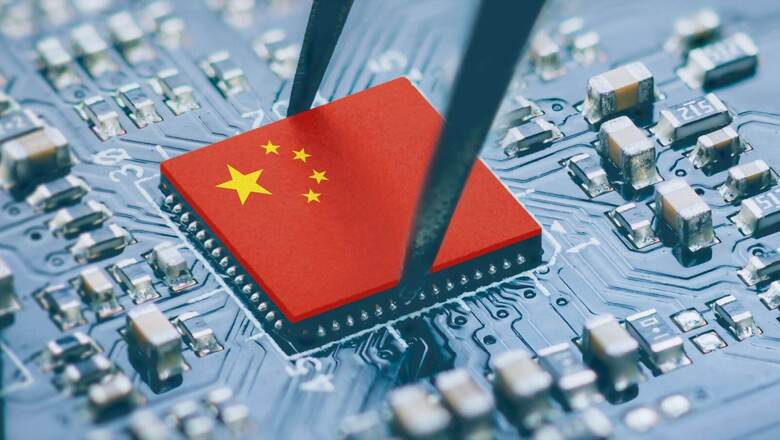
views
When President Joe Biden decided to sign the CHIPS and Science Act over a month back, it was seen as a defensive move by the United States (US) government to strengthen its national semiconductor and high-tech ecosystems. This included a massive dedicated fund for providing subsidies to domestic semiconductor and technology companies to ramp up their innovation, production and ability to compete in the global market.
However, a few weeks later, in a series of offensive actions, extensive restrictions were placed on the export of high-end and advanced semiconductors to China. This comes six months after the US decided to use technology sanctions as a punitive tool against Russia for the invasion of Ukraine.
Since the Covid-19 pandemic wreaked havoc on the global semiconductor supply chains in 2020, the Chinese semiconductor industry has showcased incredible growth every quarter. Bloomberg’s report earlier this year showcased how over 90 percent of the world’s fastest-growing semiconductor firms since 2020 have belonged to China. Coincidently, this was the same time the US started imposing technology sanctions on China, especially in the semiconductor domain.
This included export restrictions on semiconductor manufacturing equipment such as photolithography machines, limited access to leading-edge fabs and blocking the sale of Chinese products in American markets. However, the last two years have had the exact opposite effect of what the sanctions and restrictions were meant to achieve. China’s global technological and semiconductor footprint has grown continuously and threatens to challenge the US for technological supremacy. What makes the recent sanctions by the US different, what might be China’s response to this and the big question, will they work?
What has Changed?
First, some restrictions have transcended the geopolitical realm and have had a significant spill-over effect on the private sector. The recent sanctions have disallowed the sale of advanced computing chips, such as AI chips and leading-edge chipsets, to all Chinese firms and the military due to their potential applications in developing high-grade weapon systems. It was a significant blow for established American semiconductor firms that have grown immensely over the past two decades due to China being their biggest market. With demand at an all-time high, such firms, due to rising geopolitical tensions in the technology sector, will have a hard time substituting for the Chinese market. The private sector now has to abide by the rules made by the government or face action. This has made these sanctions the first to affect America’s domestic industry in its bid to challenge China’s rise.
Second, the current sanctions by the US are so broad that they can inflict a lot of economic pain on China and other semiconductor powers. The sanctions cover not only American firms and their products but also any other firm worldwide using any sort of American technology to develop their products. This would mean that it is not only American chipsets and products that China cannot access but every other country and their companies’ products that remotely uses any American IP, design tool, manufacturing equipment and technology. This would mean that many of their imports from Europe would be hit.
One of China’s major chip suppliers, South Korea, would also have to adhere to these sanctions. With China traditionally being a massive market for South Korean companies, these broad sanctions by the US can trigger another supply chain disruption. While these high-tech sanctions were meant to be the fulcrum of the geopolitical tussle between the US and China, the recent sanctions have invariably involved other states in the conflict.
Third, semiconductors and chips are no more the only areas of high-tech in which the sanctions are being targeted. The US government has declared that restrictions will be placed across other emerging tech sectors such as AI, Quantum and Biotechnologies. The already imposed sanctions will have a massive bearing on the development of other emerging tech sectors because chips and semiconductor devices form the basis for these. This was seen during the US and its technology sanctions on Russia during the beginning of the Ukraine conflict when Russia was cut off chip supplies leading to a cascading effect in other tech sectors at the domestic level.
Anticipating China’s Response
With the sanctions possibly disrupting the functioning of global supply chains and affecting both governments and businesses, one has to wonder what response China might go to when such harsh restrictions have been imposed on them. This can trigger a chain reaction of back-and-forth high-tech tensions between the two technological powers, eventually spilling the conflict into other domains. Historically, evidence has shown that sanctions and restrictions imposed on China, especially in the technology arena, have not worked. This just exacerbates the anticipation around China’s response to these recent sanctions.
China might resort to illegal methods to circumvent the restrictions, such as industrial espionage. Last month, the biggest semiconductor foundry in China, SMIC, unveiled its new 7nm chip. The chip’s design was rumoured to be modelled precisely on TSMC’s chip which was released over five years ago. This raised concerns about whether the Chinese technology industry has inside access to technological advancements in other states. The fears of industrial espionage across the Taiwan straits have reached a new peak, especially with the rising tensions between the mainland and the island nation. Increasing espionage efforts are a real threat and one of China’s probable response mechanisms to the imposed sanctions.
It has also been seen that every time technology restrictions have been placed on China, the response from the country has been tremendous scientific and technological growth. When export controls were put on cryogenic systems preventing access to the technology in building superconducting quantum computers, China circumvented the restriction by developing the world’s fastest phonic quantum computer and advanced Helium cooling to mimic the working of cryogenics.
When ASML, a Dutch company, was prevented from exporting Extreme Ultraviolet (EUV) photolithography machines to China to produce leading-edge chips, SMIC and China used Deep Ultraviolet (DUV) machines (a rung lower than EUV) to achieve the task. When put in a difficult place, China has resorted to workarounds and alternatives to eliminate such restrictions. This might be a catalyst for China’s technological advancements in the semiconductor and other high-tech industries, eventually leapfrogging the same ones who imposed the restrictions.
The recent export controls and sanctions by the US are some of the harshest that the world has seen in the technology realm. Due to the extremity of the sanctions, spill-over effects are likely to affect the private sector, other technologically advanced states and the global ecosystem. Hence, the rest of the world must be prepared for China to respond to these actions aggressively. Either way, this will be a catalyst for technology decoupling and China pursuing its own path towards so-called ‘technology self-sufficiency’.
Arjun Gargeyas is an IIC-UChicago Fellow and a Consultant at the Ministry of Electronics and Information Technology (MeitY), Government of India. The views expressed in this article are those of the author and do not represent the stand of this publication.
Read all the Latest Opinions here

















Comments
0 comment